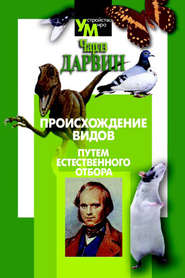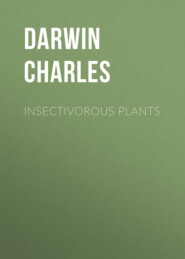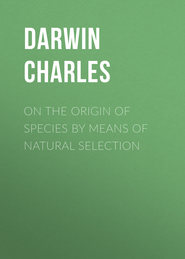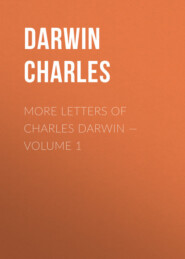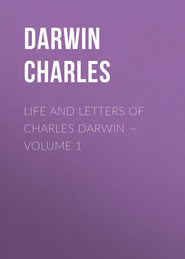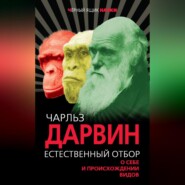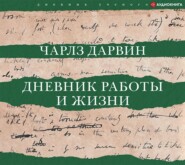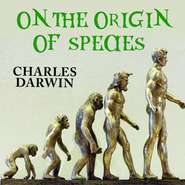По всем вопросам обращайтесь на: info@litportal.ru
(©) 2003-2024.
✖
The Origin of Species by Means of Natural Selection
Настройки чтения
Размер шрифта
Высота строк
Поля
ABNORMAL. – Contrary to the general rule.
ABORTED. – An organ is said to be aborted, when its development has been arrested at a very early stage.
ALBINISM. – Albinos are animals in which the usual colouring matters characteristic of the species have not been produced in the skin and its appendages. Albinism is the state of being an albino.
ALGAE. – A class of plants including the ordinary sea-weeds and the filamentous fresh-water weeds.
ALTERNATION OF GENERATIONS. – This term is applied to a peculiar mode of reproduction which prevails among many of the lower animals, in which the egg produces a living form quite different from its parent, but from which the parent-form is reproduced by a process of budding, or by the division of the substance of the first product of the egg.
AMMONITES. – A group of fossil, spiral, chambered shells, allied to the existing pearly Nautilus, but having the partitions between the chambers waved in complicated patterns at their junction with the outer wall of the shell.
ANALOGY. – That resemblance of structures which depends upon similarity of function, as in the wings of insects and birds. Such structures are said to be ANALOGOUS, and to be ANALOGUES of each other.
ANIMALCULE. – A minute animal: generally applied to those visible only by the microscope.
ANNELIDS. – A class of worms in which the surface of the body exhibits a more or less distinct division into rings or segments, generally provided with appendages for locomotion and with gills. It includes the ordinary marine worms, the earth-worms, and the leeches.
ANTENNAE. – Jointed organs appended to the head in Insects, Crustacea and Centipedes, and not belonging to the mouth.
ANTHERS. – The summits of the stamens of flowers, in which the pollen or fertilising dust is produced.
APLACENTALIA, APLACENTATA or APLACENTAL MAMMALS. – See MAMMALIA.
ARCHETYPAL. – Of or belonging to the Archetype, or ideal primitive form upon which all the beings of a group seem to be organised.
ARTICULATA. – A great division of the Animal Kingdom characterised generally by having the surface of the body divided into rings called segments, a greater or less number of which are furnished with jointed legs (such as Insects, Crustaceans and Centipedes).
ASYMMETRICAL. – Having the two sides unlike.
ATROPHIED. – Arrested in development at a very early stage.
BALANUS. – The genus including the common Acorn-shells which live in abundance on the rocks of the sea-coast.
BATRACHIANS. – A class of animals allied to the Reptiles, but undergoing a peculiar metamorphosis, in which the young animal is generally aquatic and breathes by gills. (Examples, Frogs, Toads, and Newts.)
BOULDERS. – Large transported blocks of stone generally embedded in clays or gravels.
BRACHIOPODA. – A class of marine Mollusca, or soft-bodied animals, furnished with a bivalve shell, attached to submarine objects by a stalk which passes through an aperture in one of the valves, and furnished with fringed arms, by the action of which food is carried to the mouth.
BRANCHIAE. – Gills or organs for respiration in water.
BRANCHIAL. – Pertaining to gills or branchiae.
CAMBRIAN SYSTEM. – A series of very ancient Palaeozoic rocks, between the Laurentian and the Silurian. Until recently these were regarded as the oldest fossiliferous rocks.
CANIDAE. – The Dog-family, including the Dog, Wolf, Fox, Jackal, etc.
CARAPACE. – The shell enveloping the anterior part of the body in Crustaceans generally; applied also to the hard shelly pieces of the Cirripedes.
CARBONIFEROUS. – This term is applied to the great formation which includes, among other rocks, the coal-measures. It belongs to the oldest, or Palaeozoic, system of formations.
CAUDAL. – Of or belonging to the tail.
CEPHALOPODS. – The highest class of the Mollusca, or soft-bodied animals, characterised by having the mouth surrounded by a greater or less number of fleshy arms or tentacles, which, in most living species, are furnished with sucking-cups. (Examples, Cuttle-fish, Nautilus.)
CETACEA. – An order of Mammalia, including the Whales, Dolphins, etc., having the form of the body fish-like, the skin naked, and only the fore limbs developed.
CHELONIA. – An order of Reptiles including the Turtles, Tortoises, etc.
CIRRIPEDES. – An order of Crustaceans including the Barnacles and Acorn-shells. Their young resemble those of many other Crustaceans in form; but when mature they are always attached to other objects, either directly or by means of a stalk, and their bodies are enclosed by a calcareous shell composed of several pieces, two of which can open to give issue to a bunch of curled, jointed tentacles, which represent the limbs.
COCCUS. – The genus of Insects including the Cochineal. In these the male is a minute, winged fly, and the female generally a motionless, berry-like mass.
COCOON. – A case usually of silky material, in which insects are frequently enveloped during the second or resting-stage (pupa) of their existence. The term "cocoon-stage" is here used as equivalent to "pupa-stage."
COELOSPERMOUS. – A term applied to those fruits of the Umbelliferae which have the seed hollowed on the inner face.
COLEOPTERA. – Beetles, an order of Insects, having a biting mouth and the first pair of wings more or less horny, forming sheaths for the second pair, and usually meeting in a straight line down the middle of the back.
COLUMN. – A peculiar organ in the flowers of Orchids, in which the stamens, style and stigma (or the reproductive parts) are united.
COMPOSITAE or COMPOSITOUS PLANTS. – Plants in which the inflorescence consists of numerous small flowers (florets) brought together into a dense head, the base of which is enclosed by a common envelope. (Examples, the Daisy, Dandelion, etc.)
CONFERVAE. – The filamentous weeds of fresh water.
CONGLOMERATE. – A rock made up of fragments of rock or pebbles, cemented together by some other material.
COROLLA. – The second envelope of a flower usually composed of coloured, leaf-like organs (petals), which may be united by their edges either in the basal part or throughout.
CORRELATION. – The normal coincidence of one phenomenon, character, etc., with another.
CORYMB. – A bunch of flowers in which those springing from the lower part of the flower stalks are supported on long stalks so as to be nearly on a level with the upper ones.
COTYLEDONS. – The first or seed-leaves of plants.
CRUSTACEANS. – A class of articulated animals, having the skin of the body generally more or less hardened by the deposition of calcareous matter, breathing by means of gills. (Examples, Crab, Lobster, Shrimp, etc.)
CURCULIO. – The old generic term for the Beetles known as Weevils, characterised by their four-jointed feet, and by the head being produced into a sort of beak, upon the sides of which the antennae are inserted.
CUTANEOUS. – Of or belonging to the skin.
DEGRADATION. – The wearing down of land by the action of the sea or of meteoric agencies.
DENUDATION. – The wearing away of the surface of the land by water.
DEVONIAN SYSTEM or FORMATION. – A series of Palaeozoic rocks, including the Old Red Sandstone.
DICOTYLEDONS, or DICOTYLEDONOUS PLANTS. – A class of plants characterised by having two seed-leaves, by the formation of new wood between the bark and the old wood (exogenous growth) and by the reticulation of the veins of the leaves. The parts of the flowers are generally in multiples of five.






